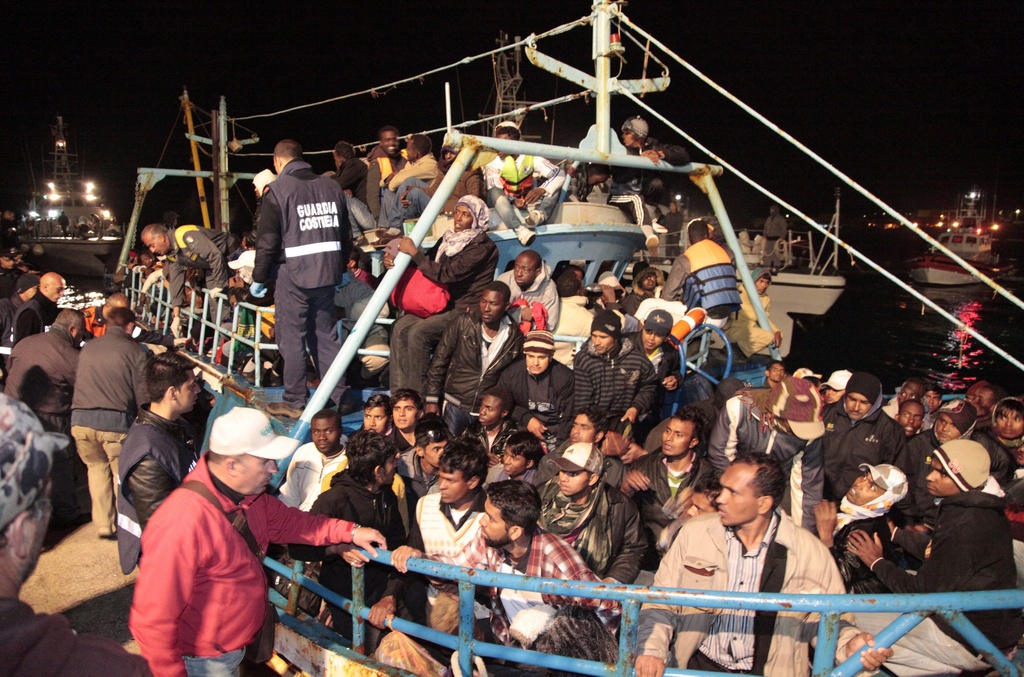
Justice minister stresses fair asylum policy

As the Swiss Refugee Council marks Refugee Day on June 18 with a focus on what refugees have to offer society, European states worry about a new wave of asylum seekers.
Swiss Justice Minister Simonetta Sommaruga, tells swissinfo.ch that she wants to simplify and speed up the asylum process, while ensuring that it remains fair.
There is a real dilemma: in the world as a whole, tens of millions of people are in flight from persecution, violence and disaster, but no one wants to take them in – least of all the rich countries of the West.
swissinfo.ch: Which side do you stand on in this dilemma, when so many people are in flight, and no one is willing to accept them?
Simonetta Sommaruga: I am on the side of a credible asylum policy, which needs to ensure that a people who are at risk in their own country will be accepted.
My aim is to have fair procedures that will offer protection to people who have good reason to flee their home country as defined in the 1951 [United Nations] refugee convention. Anyone who does not have a recognised reason to be a refugee must go back.
swissinfo.ch: No one flees for no reason.
S.S.: Where there are reasons for flight, we must offer help in construction and development to create a functioning political system and economic policy, so that poor countries in particular get a chance to develop an independent economy.
swissinfo.ch: One result of the Arab Spring is that worldwide even more refugees have been seeking asylum. Is it not hypocritical to applaud the democratic developments there, and at the same time try to fend off a possible wave of refugees?
S.S.: Switzerland did not merely applaud, but gave aid. The government quickly promised SFr12 million ($14 million) and Switzerland was one of the first countries to freeze dictator’s assets.
Most of those coming from Tunisia are economic migrants, young men looking for jobs here. I can understand why they come, but they will not get asylum and must go back.
It is important that we take seriously the concerns of people in Switzerland, and that we should be ready if suddenly a large number of people seek asylum. That has nothing to do with fending them off, but rather to do with acting responsibly towards our own population.
swissinfo.ch: Nearly half the 900,000 refugees from Libya are living in makeshift camps in Tunisia. The UNHCR has asked the rich countries of Europe to take in some of these refugees. Why doesn’t Switzerland, as a humanitarian country, set a good example here?
S.S.: But it is. You mustn’t forget that Switzerland has already taken in large numbers of refugees from Eritrea. And we have taken in more Eritreans this year who fled from Libya. We have the biggest Eritrean diaspora in the whole of Europe. It is natural for more Eritreans to come, because they know people here.
I don’t want to play off these refugees against the ones in camps in Tunisia, but rather to maintain Switzerland’s humanitarian tradition.
swissinfo.ch: The procedure for those who come knocking at our doors is to be greatly speeded up, you have announced. Will that curtail the legal remedies open to asylum seekers?
S.S.: Until now the procedures could take more than 1,000 days. That is extremely tough for the applicants as well. We have a lot of reasons to shorten the procedure, but not by undermining quality.
What we want to do is combine in a single asylum procedure the many steps which were previously carried out in different places and over several months. At the same time the people are to receive free and comprehensive legal protection. The procedures should be fair. That’s why they must be carried out quickly and in a professional way.
swissinfo.ch: Under the Dublin agreement Switzerland can return refugees to the country of first asylum. Are you ready to accept that refugees who have applied to us could be returned to Italy, for example, where the desperate conditions in asylum centres are repeatedly in the headlines?
S.S.: I am aware that a very large number of people – about 40,000 – have arrived in Italy from Libya. On Lampedusa alone there were up to 5,000 refugees, which put an intolerable strain on the island’s infrastructure. Italy has now taken these people to the mainland and put them in accommodation.
swissinfo.ch: And if even more people come, will Switzerland be among those helping to ease the burden on Italy?
S.S.: At a meeting of the Schengen-Dublin states we established that the situation is such that Malta, for example, cannot cope. In the space of four months, the country has had 2,700 refugees, including many women and children. That would be proportionately equivalent to 40,000 people in Switzerland.
The EU Commission sent not only experts but also money to support Malta, and the EU countries have said they are ready to take refugees from Malta.
swissinfo.ch: Switzerland too?
S.S.: Switzerland too has offered to take a small group of refugees from Malta. But I also said in Brussels that we currently have a lot of applications from Eritrea. Each European country should make its own contribution – voluntarily. But if there’s no solidarity, the whole Dublin system will fall apart, and that is in nobody’s interest.
Refugees have talent, knowledge, ability and motivation, and can make a great contribution to society.
The Swiss Refugee Council has chosen stories of escape and new beginnings for its June 18 campaign.
To mark its 75th anniversary, it has put together 75 portraits of refugees now living in Switzerland.
The stories show how social integration helps people enter the job market.
The campaign is backed by the Refugee Council, the Swiss office of the UNHCR and the Federal Migration Office.
At the end of 2010 there were 43.7 million displaced people worldwide, up from 43.3 million in 2009, according to the UN High Commissioner for Refugees (UNHCR).
Of these, 15.4 million had fled to other countries – 80 per cent of them to nearby developing countries.
Another 27.5 million were internally displaced – i.e. within their own country.
Asylum seekers who have lodged claims account for another 850,000.
Slightly more than half of all refugees are children under 18.
The largest group of refugees are Afghans (3 million), many of whom left their homeland many years ago.
There were 1.6 million refugees in Europe, down by 40,700 the year before.
There were about 4 million in Asia, 2.1 million in Africa, nearly 7 million in the Middle East and North Africa, and 800,000 in the Americas.
(Translated from German by Julia Slater)

In compliance with the JTI standards
More: SWI swissinfo.ch certified by the Journalism Trust Initiative






























You can find an overview of ongoing debates with our journalists here . Please join us!
If you want to start a conversation about a topic raised in this article or want to report factual errors, email us at english@swissinfo.ch.